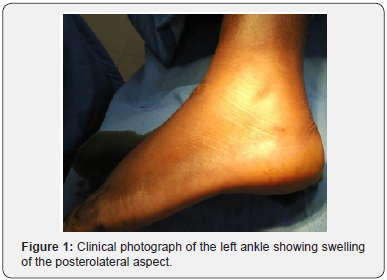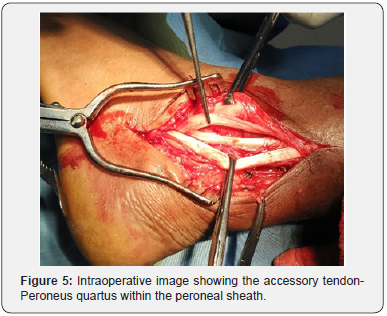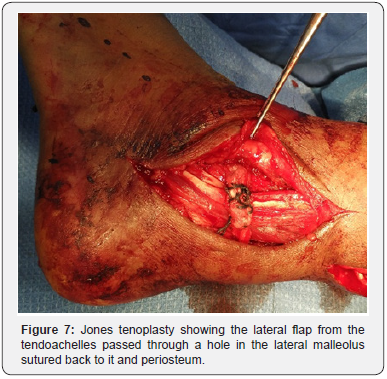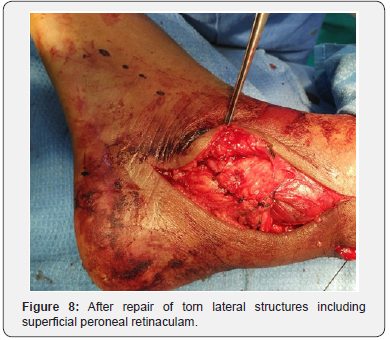Juniper Publishers- Open Access Journal of Case Studies
Recurrent Peroneal Tendon Subluxation with Peroneus Quartus Muscle: A Case Report and Brief Review of Literatures
Authored by Balaji Zacharia
Abstract
Peroneal tendon subluxation is a very rare condition. The most common cause is trauma. It manifests clinically as lateral ankle pain and instability. Magnetic resonance imaging is the best investigation to detect it. Various procedures such as reinforcement of superior peroneal retinaculum and deepening of retromalleolar groove have been described for the treatment of peroneal subluxation. Here we describe a case of recurrent peroneal tendon subluxation in a 45 year old male following ankle trauma. Surgical correction by a Jones tenoplasty was planned and operative exploration revealed the presence of an accessory Peroneus quartus muscle in the sheath. The patient was completely asymptomatic at the 8th month follow up. We report this case to highlight the association of an accessory peroneal muscle in cases of peroneal tendon subluxation and effectiveness of a simple tenoplasty procedure in such situations.
Introduction
Peroneus longus and brevis are the main evertors of the foot. They also help in plantar flexion of the ankle. Peroneus longus acts as a suspensory sling for maintaining the transverse arch of the foot [1]. It originates from the upper two third of the lateral surface of fibula, inter osseous membrane and lateral tibial condyle. Peroneus brevis takes its origin from the lower two thirds of fibula. Both muscles descend close to posterior surface of fibula with longus lying superficial to brevis. Behind the lateral malleolus both tendons occupy a common synovial sheath in a groove behind the lateral malleolus. They are held in position by the superior peroneal retinaculum [2]. Beyond this both tendons run antero-inferior to lateral malleolus over the calcaneum and cuboid. Over the calcaneum, the peroneus brevis tendon passes above and longus tendon passes below the peroneal trochlea to which inferior peroneal retinaculum attaches [3]. Peroneus longus inserts on to the medial cuneiform and base of first metatarsal. Peroneus brevis attaches to the base of fifth metatarsal. Both muscles are supplied by the superficial peroneal nerve [4]. The blood supply to the peroneal tendons is from the posterior peroneal artery and the medial tarsal artery [5]. A low lying Peroneus brevis muscle is a relatively common variant where the muscle belly extends below the upper margin of superior peroneal retinaculum. The position of its musculotendinous junction can be affected by the position of the foot [6].
The retromalleolar groove is a fibro osseous tunnel bounded anteriorly by the osseous groove behind the fibula, postero-inferiorly by the tibiofbular ligament and posteriorly by the superior peroneal retinaculum, posterior talofibular ligament and calcaneofibular ligament [2]. It has a concave morphology proximally in most individuals. The shape of the groove has a bearing on the stability of the tendons lying in it. The shape of groove in its distal aspect is determined mainly by the thick fibrocartilage periosteal cushion over the bony groove and not by the bone itself [3]. The surface area of groove is increased laterally by the non-osseous fibrocartilage ridge and medially by the periosteal cushion. Subluxation of the peroneal tendons over the lateral malleolus occur when the peroneal retinaculam loses its integrity following a sprain or due to anatomical variations at the retromalleolar groove resulting in reduced conformity between the tendons and the groove [4,5].
An accessory muscle called peroneus quartus may be present in the peroneal sheath. It is the most common accessory muscle of the foot and ankle [7]. It was first described by Otto in 1816 and later researched by Hecken [8]. There is considerable difference in the prevalence of this muscle between 10 to 26% [9-11]. Similar to the peroneus tertius, the Peroneus quartus is unique to humans due to their bipedal posture. It acts as a lateral stabiliser of foot, and also supports the lateral edge of foot during eversion [12-14]. Peroneusquartus originates usually from peroneus brevis in most cases and rarely from peroneus longus or from distal fibula and inserts on to several structures such as peroneal trochlea of calcaneum, peroneus brevis, peroneus longus, cuboid or base of fifth metatarsal [13,14]. Peroneus quartus can produce lateral ankle pain, subluxation of peroneal tendon, rupture, peroneus brevis degeneration and calcification [15]. Here we describe the clinical features, investigations and management of 45 year old man with recurrent subluxation of peroneal tendons due to an anomalous peroneus quartus muscle.
Case Presentation
A 45 year old male farmer with one and half year history of painful left ankle presented to our outpatient clinic. Patient gave history of a twisting injury to the left ankle prior to onset of pain. An initial diagnosis of ankle sprain was made and this was treated conservatively with analgesics, rest and immobilisation of the ankle for 20 days. Following this he reported recurrent episodes of giving-away feeling of the ankle, which were managed conservatively with analgesics by local practitioners’. There was no history of fever, constitutional symptoms or involvement of other joints. Clinical examination revealed a boggy swelling of the posterolateral aspect of left ankle (Figure 1). Subluxation of the peroneal tendons during the arc of movement at the ankle could be visually appreciated as well as palpated.

Serum calcium, uric acid, total and differential leukocyte count and ESR were within normal limits. The anteroposterior and lateral radiographs were normal except for an Ostrigone (Figure 2). An ultrasonogram was done which showed thickening of peroneal tendons with synovial hyperplasia and effusion suggesting peroneal tenosynovitis. Magnetic resonance imaging of left ankle showed few small osseous intensity structures along the posterior and lateral margins of the joint probably loose bodies. Hyper-intense signals were noted around peroneus brevis tendon and there was significant peri-tendinous fluid collection indicating peroneal tenosynovitis. Few tiny subcortical PD-FS hyper-intense foci were seen along the articular surface of tibio-talar joint indicating coexistent osteoarthritis (Figure 3). Based on the clinical findings and investigations a diagnosis of recurrent subluxation of peroneal tendons with peroneal tenosynovitis was made.


Surgical correction by a Jones procedure and suturing of the torn lateral structures was planned. Informed consent was obtained for the surgery. After giving subarachnoid block the patient was positioned in a semi prone fashion. Surgical exposure was done through 10cm long longitudinal posterolateral incision. Intraoperatively, there was a longitudinal tear noted in the peroneal tendon sheath and the peroneus brevis tendon was found to be subluxated anteriorly and lying over the fibula (Figure 4). An accessory tendon was found between peroneus longus and brevis. It was identified as peroneus quartus (Figure 5). All tendons were reduced into the retro-fibular groove. A 0.5cm wide tendo achilles flap was taken using a 10cm long incision on the tendon through the same exposure (Figure 6). A drill hole was made over the lateral malleolus and the flap was taken through the drill hole and sutured back on to itself and to the periosteum (Figure 7). Lastly the torn lateral structures and the retinaculum were repaired (Figure 8). The wound was closed in layers and a below knee slab was given for 6 weeks followed by a walking cast for the next 2 weeks. Follow up evaluation was uneventful and at the final follow up at 8 months the patient was symptom free.





Discussion
This case report is being reported owing to the rarity of recurrent subluxation of peroneal tendons and an even more rare association of this condition with the peroneus quartus accessory tendon. This case shows that the orthopaedic surgeon should have a high index of suspicion to avoid the delay in diagnosis and also highlights the effectiveness of a simple procedure like Jones procedure in the treatment of recurrent subluxation of peroneal tendons.
Peroneal tendon subluxation is an uncommon cause of lateral ankle pain and instability [16]. The common causes include injury during contact sports like soccer, rugby, gymnastics etc [17]. Spontaneous non-traumatic subluxation can occur in individuals with generalised ligamentous laxity and with a hypoplastic retro-fibular groove [18]. The most common mechanism is a superficial peroneal retinaculum tear following ankle injury involving sudden violent contraction of peroneal tendons in dorsiflexion and inversion [19]. The Eckert and Davis classification for peroneal tendon subluxation modified by Oden is the most widely accepted classification. It divides the injury into four grades according to the severity and instability [20,21].
Patients usually present with pain in the lateral ankle following twisting injury. They may complain of instability while walking on uneven surfaces or a snapping sensation around the lateral malleolus. In chronic cases there will be retromalleolar pain and recurrent instability. Clinical examination will show tenderness in the retromalleolar region with edema. Passive plantar flexion and eversion of the ankle will be painful. Passive circumduction of ankle will reproduce the subluxation of peroneal tendons [22]. A clinical test for diagnosing peroneal subluxation was described by Safran et al [23]. Here the patient lies prone with knee kept in 90 degrees of flexion and the ankle is passively plantar and dosiflexed with resisted eversion to look for subluxation of tendon [23].
The common investigation done to diagnose peroneal tendon subluxation includes a dynamic ultrasound which is an excellent investigation in experienced hands [24]. Routine radiography will be negative in most cases but rarely an avulsion fracture of superior peroneal retinaculum can be seen (fleck sign). Magnetic resonance imaging is the best modality of investigation as it gives soft tissue details and shows the integrity of peroneal sheath and tendons [5]. Computerised tomographic scan may be useful for planning retro fibular groove deepening procedures [25].
Non operative treatment for acute injuries involve immobilisation in a below knee cast for six weeks but the results are not good [5]. The best results can be achieved with surgical treatment both for acute and recurrent subluxation. The aim of surgical treatment is stabilisation of the peroneal tendon in the retro fibular groove and repair or reconstruction of superior peroneal retinaculum [25]. Various procedures are described but there is no evidence to suggest superiority of any technique. Direct repair of the torn superficial peroneal retinaculum and tenoplasty using achilles tendon or plantaris tendon can be done as described by Jones and recently by Escalas [26]. Deepening of retro fibular groove and bone block procedures to deepen the groove has been described with inconsistent results. Accessory peroneal muscle and anomalous location of peroneal muscles causing functional crowding can be associated with recurrent subluxation [27,28].
Conclusion
Peroneal tendon subluxation is a rare entity most commonly seen following twisting injury to the ankle. Careful clinical and radiological evaluation is necessary to accurately treat the condition and prevent recurrence. In this report we described a case of recurrent subluxation of peroneal tendon following an injury. This case shows that the orthopedician should have a high index of suspicion to avoid the delay in diagnosis and also highlights the effectiveness of a simple procedure like Jones procedure in the treatment of recurrent subluxation of peroneal tendons.
For more articles in Open Access Journal of Case Studies please click on: https://juniperpublishers.com/jojcs/index.php



No comments:
Post a Comment